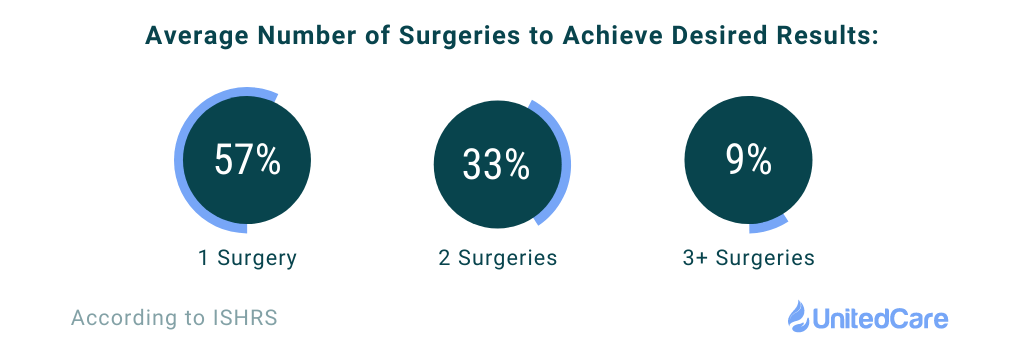Important Info
Hair Transplant Rejection is not a proper term since to be able to use the word “rejection” in hair transplantation, you have to transplant/implant someone else’s hair. Currently, all hair transplants are autologous.
From now on we will use “Hair Transplant Rejection” term to refer to
“Hair Transplant Failures“.
The success of a hair transplant is not determined right after the surgery.
It’s not determined after your scalp is healed.
It isn’t even determined once your transplanted hair starts growing.
The real success of a hair transplant is determined by the percentage of grafts that survived after a long period of time, usually 12-18 months. That’s because there isn’t any guarantee that your transplanted hair will stay on your scalp.
In fact, although hair transplant failures are pretty uncommon; inattentive physicians, outdated methods, or neglection by the patient can drastically improve your chances of failing your hair transplant.
TL;DR
➡ A hair transplant process involves surgery, post-surgery process, and beforehand. Its success is determined 12-18 months after the surgery, based on how many of your transplanted grafts survived.
➡ Your scalp can reject the transplanted hair based on your surgeon’s harvesting abilities and medical history.
➡ To avoid outdated transplant methods, unattentive doctors, and poor post-surgery care, finding a clinic with an experienced dermatologist is best.
➡ Many options for rejected hair transplants, such as Minoxidil or Finasteride, are possible. Your doctor will give you the best option based on your medical background.
In this quick blog post, I’ll talk about what a hair transplant rejection is, why it happens, and how it can be avoided.
Table of Contents
But, let’s first properly answer the question:
Can a Hair Transplant be Rejected (Failed)?
Yes, a hair transplant can be rejected by your body. This doesn’t mean that your body doesn’t accept the transplanted hair follicles (as seen in kidney, liver, or heart transplantations) but means transplanted hair growth won’t be promoted due to various factors.
There are many cases where the newly planted hair starts to fall out months after the surgery, slowly pushing the patient’s progress backward.
The fact that a hair transplant can also fail and be rejected by your body can be a tough piece of information to face for patients considering hair transplants.
It is better to know what can go wrong with a medical procedure beforehand for a couple of reasons.
First off, you’re aware of the worst thing that can happen, and also know what your chances of succeeding are.
Second, it can help you decide if you would be able to handle the worst-case scenario, mentally and physically.
And thirdly and most importantly, knowing the risks of a procedure helps you ensure you’re doing everything you can to reduce the chances of complications happening.
That’s why I almost always try to inform my hair transplant patients about the complications that can occur beforehand; the mental and physical health of the patient should always outweigh the pecuniary elements. So I’d suggest you understand all the scenarios and outcomes before setting an operation date.
What Exactly is a Hair Transplant Rejection (Failure)?
A hair transplant rejection is a condition that can occur some time after a hair transplant where the majority of newly transplanted hair is lost. The transplanted hair follicles start to fall out from your scalp one after another until progressively all or most of your new hair is gone and you’re back to where you were before the operation.
And believe me when I say that is not even the biggest downside of a hair transplant failure.
The biggest downside is that the hair follicles that fall out were harvested from the donor area of your scalp, and these hair follicles are never replaced.
So, a surgeon’s ability to harvest donor hair from the donor area is critically limited after the first surgery. The most important reasons for this are the skin texture changes that occur due to a previous misconducted hair transplant operation. These changes make it difficult to remove the donor zone hair.
This can prevent them from properly fixing the rejected hair transplant, or performing a second surgery to cover up the re-emerging bald areas.
Why does a Hair Transplant get rejected?
For a hair transplant to be successful, all the variables should be perfect.
The hair transplant procedure should go perfectly, the post-operation care should be more than sufficient, and you should avoid anything that could affect your grafts’ survival.
Naturally, there are a couple of ways each of these variables can go terribly wrong.
Let’s look at the top four reasons behind a hair transplant rejection:
1- Lichen Planopilaris
Lichen Planopilaris, commonly referred to as LPP, is a scarring type of hair loss caused by inflammation. Signs include itching, pain; and perifollicular erythema or perifollicular scale when examined carefully.
Although it is an uncommon condition as a cause of hair loss in men and women, it holds a much higher percentage as a reason for hair transplant rejections.
In Lichen Planopilaris, the inflammation completely destroys and replaces a hair follicle with scarring, which causes permanent loss of hair in the affected area.

The exact cause of the condition is unknown, but a study suggests it might be due to a sort of autoimmune process.
It can be treated with topical or oral solutions and medications, but the success rates in treatments vary a lot, and there is a very low chance for a patient to not respond to the treatment.
2- Inattentive and Inexperienced Physicians
A hair transplant is a medical surgery that should be handled by a medical professional, specifically dermatologists. Because all diseases about skin and hair are in the field of dermatology and there is no other specialty in medicine that takes necessary education during residency programs.
But most clinics lack this and employ inexperienced physicians that aren’t even related to the field of dermatology.
Therefore, these physicians who operate on your scalp lack the experience and knowledge about your skin and hair, and will not be aware of the needs or conditions of each patient. The course of action suggested by these physicians will not be personalized and perfected for you and your body.

So, an inexperienced and inattentive physician can decrease the chances of your hair transplant surgery being 100% successful.
3- Outdated Methods
Another possible reason behind a hair transplant rejection is definitely the method used for hair transplant surgery.
Today, two types of hair transplant methods are commonly used; Follicular Unit Transplantation (FUT) and Follicular Unit Extraction (FUE).
When comparing FUE vs. FUT, you’ll see that both of these methods are similar at their core, but there are many variations and advancements to every step of the surgery.
First off, the FUE method has many advanced variations such as DHI, Sapphire FUE, and robotic transplants, which equip the surgeon with better tools that eliminate frictions during the surgery.
And also, there is the recently introduced concept of bio-enhanced hair restoration, which is not available in many clinics but is very helpful in ensuring the survival of hair grafts as they connect with your body’s blood supply.
Making sure your clinic adopts the most developed and efficient methods is a must for a successful hair transplant.
4- Poor Post-op Care by the Patient
You might also cause the rejection of your hair transplant yourself.
Let me explain:
After a hair transplant surgery, you need to provide your body with everything it will need for new hair growth from the transplanted grafts while avoiding anything that might aggravate hair loss.
For starters, getting hydrated enough, reducing consumption of alcohol and smoking, mildly and regularly exercising, avoiding the sun, and maintaining a balanced and healthy diet are good practices.

Check out our guide to Post Hair Transplant Care if you want to learn more about what should and shouldn’t be done after the surgery.
Or, check out our Hair Loss Causes article to understand what causes hair loss, so you can ensure you avoid them.
As with any other medical condition, make sure you have a healthy lifestyle to ensure the success of your hair loss.
Can you treat a Rejected Hair Transplant?
It is not possible to totally reverse unsuccessful hair transplantation. What is gone is gone, especially limited and precious DHT-resistant donor hairs.
However, there are two possible treatments to a rejected hair transplant to make the result look better:
Promote and Supplement Hair Growth
Your newly transplanted hair might be growing poorly and falling out, but if you’re not gone too far, there is still hope for achieving success.
Topical Rogaine/Minoxidil is proven to boost hair growth post hair transplant and increase graft survival.
Using Oral Finasteride was also proven to improve hair growth after the operation and increase thickness and hair count.
Also, injection of Platelet-rich Plasma (PRP) was seen to improve recovery and density after a hair restoration surgery.
Undergoing the Second Hair Transplant Surgery
If the hair loss caused by the hair transplant rejection further progresses and the hair loss seems to be permanent, you will need a second hair transplant to achieve success.
There is no need to worry, though; according to hair transplant statistics, it takes the average patient 3.4 surgical procedures to achieve their desired result.

Once the reason for the rejection is determined, you can see your dermatologist and schedule a time for the second surgery to make it right.
How to Make Sure Your Body Doesn’t Reject the Hair Transplant
To avoid hair transplant rejection, make sure you’re aware of what you’re getting into first. A hair transplant doesn’t only cost you money; the time and effort it requires to succeed costs much more than the price you pay in money.
And more importantly, make sure you’re getting the best treatment possible.
At UnitedCare, we set high-quality standards for all the clinics in the world’s busiest hair transplant location, Istanbul, Turkey.
Dermatologist On-Site
At UnitedCare, you are directly treated by expert dermatologists.

With over 17 years of combined experience, Dr. Utkan Kiziltac and Dr. Kubra Kiziltac are present at the clinic to understand and treat your hair loss through hair transplantation.
Advanced Techniques in Practice
At UnitedCare, we use Sapphire FUE and Direct Hair Implantation to improve surgical procedures and increase the chances of success for our patients.
Also, we’ve adopted ISHRS recognized bio-enhancements to boost survival, recovery, and growth of transplanted hair follicles.

These practices and techniques are not used by many clinics to cut costs, but we prioritize health.
Holistic Approach to Hair Transplantation
And lastly, from the first consultation call you have with us all the way to your first year after the hair transplant surgery, we value each step equally.
We believe in treating hair loss as a whole and helping you live a worry-free life moving forward.
So, make sure you get your hair transplant in a clinic that offers all of these points as we do at UnitedCare.
Or better yet, get your hair transplant at UnitedCare and ensure success:
You can avoid rejections and ensure success with UnitedCare’s expert dermatologists.
Get a free consultation right now, and we will provide you with a holistic approach to FUE surgeries:
Frequently Asked Questions (FAQs)
Can you sue for a failed hair transplant?
You can sue the clinic you’ve had your hair transplant in if you believe and can prove that there was negligence and medical malpractice on the clinic’s or physician’s end.
Who is not suitable for a hair transplant?
There are a couple of instances where a patient can be rejected from getting a hair transplant, which are: insufficient donor area, excessively large bald area, aggressive and progressing androgenetic alopecia, or medical conditions that prevent you from undergoing surgery.

